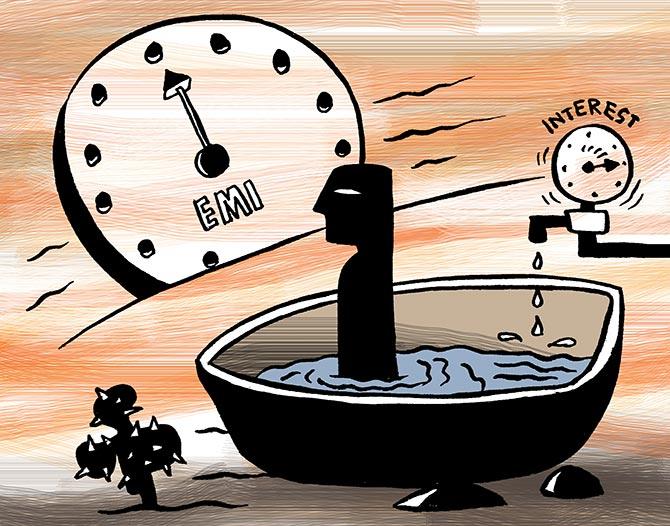 | « Back to article | Print this article |
'Banks have to be braver, willing to take more risks and give confidence to the customer,' observes Joydeep Ghosh.

Moratorium has been a keyword in the government's announcements after the COVID-19 crisis broke out.
Retail and corporate borrowers can avail of it for six months, and more importantly, micro, small and medium enterprises (MSMEs) will get it for one year.
The latter, in fact, was an important element during Finance Minister Nirmala Sitharaman's 'five-day-long, Rs 21 trillion (10 per cent of GDP)' stimulus package announcement.
The package included a Rs 3 trillion government-guaranteed loans to MSMEs.
Banks, on their part, have sent mandatory mails to all customers asking them to use the moratorium facility.
At the same time, they have also maintained 'social distancing' from it.
Sumant Kathpalia, MD and CEO of IndusInd Bank, in a call post the Q4 result announcement, said the bank was educating customers to pay the equated monthly instalments.
'We are seeing good results as they understand they have to pay extra interest if they opt for the moratorium,' he said.
The country's largest bank, State Bank of India, claims that only 20 per cent of customers have exercised that option.
In fact, some banks are even sending calculators, along with SMSes that inform you about the extension of the moratorium period, to help make an 'informed choice'.
But who is using the moratorium?
Amitabh Chaudhry, MD and CEO, Axis Bank, provided some more granular data: Two-thirds of the customers opting for a moratorium had sufficient balances in their accounts. The mantra: Conserve liquidity.
The long and short of the moratorium is that it comes at a significant cost and as of now, both banks and customers are nervous about using the option.
The government, it seems, is treating the distress among borrowers as a case of interim asset-liability mismatch.
So, the six-month or one-year moratorium on loans have been announced because it believes that borrowers, especially MSMEs, will borrow and restart businesses that have been shut due to the crisis and absence of cash flows.
The government also seems to think that within a year, these MSMEs would be in a position to repay banks and a virtuous cycle will begin.
In contrast, the FY21 gross domestic product or GDP is all set to contract.
Even the Reserve Bank of India has admitted it now.
Unemployment is at a record high.
Salary cuts/job losses are already happening en masse.
And we are still in the first quarter of FY21.
Instead of being an interim asset-liability mismatch, many MSMEs may simply shut down.
Banks who are expected to do all the heavy lifting in these programmes lack confidence.
Despite high liquidity -- Rs 8 trillion to Rs 9 trillion -- in the system, they have chosen to keep it with the RBI's reverse repo facility at 3.3 per cent.
It is true that armed with the government's guarantee, along with an interest income of 9.25 per cent, they may reach out to their existing MSME customers and extend loans to them.
But it should not be another mandatory mail, or for that matter, call exercise that is followed by the 'moratorium means more interest'.
They have to be braver, willing to take more risks and give confidence to the customer.
What would have helped both banks and MSME borrowers is an interest rate waiver or subvention scheme or a mix of both by the government.
In case of the interest waiver scheme, even if the government had borne the entire cost for the first year, it would mean an outgo of Rs 28,500 crore (assuming the entire Rs 3 trillion is disbursed).
Of course, it could also have used other options like keeping the SBI's one-year deposit rate -- 5.7 per cent -- as benchmark and paid a premium over it.
Or, an interest rate subvention scheme, like the Prime Minister Awas Yojana, and created slabs with interest rate subvention of 4 to 5 per cent.
The cost would have been limited to just Rs 15,000 crore.
Yes, some banks would have to forego some margins, but the assurance of a steady interest income at least in the first year, along with government guarantee over the four-year period, would give them more confidence that they are not throwing more good money after bad money.
And all this could have been achieved at less than 0.1 to 0.15 per cent of GDP in the first year.
During elections, states announce farm loan waivers at the drop of a hat, and last September, India Inc received significant tax sops to kick-start the economy.
MSMEs are the arteries of the economy. Revival of their 'animal spirits' is due.